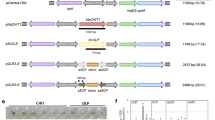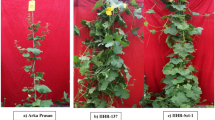Abstract
Grapefruit (Citrus paradisi) transgenic plants transformed with a variety of constructs derived from the Citrus tristeza virus (CTV) genome were tested for their resistance to the virus. Most transgenic lines were susceptible (27 lines), a few were partially resistant (6 lines) and only one line, transformed with the 3′ end of CTV was resistant. Transgene expression levels and siRNA accumulation were determined to identify whether the resistance observed was RNA-mediated. The responses were varied. At least one resistant plant from a partially resistant line showed no steady-state transgene mRNA, siRNA accumulation and no viral RNA, implicating posttranscriptional gene silencing (PTGS) as the mechanism of resistance. The most resistant line showed no transgene mRNA accumulation and promoter methylation of cytosines in all contexts, the hallmark of RNA-directed DNA methylation and transcriptional gene silencing (TGS). The variety of responses, even among clonally propagated plants, is unexplained but is not unique to citrus. The genetics of CTV, host response or other factors may be responsible for this variability.





Similar content being viewed by others
Abbreviations
- CP:
-
Capsid protein
- CPm:
-
Minor capsid protein
- CTV:
-
Citrus tristeza virus
- CU:
-
Cucumber mosaic virus (CMV) 5′ untranslated region
- DASI-ELISA:
-
Double antibody sandwich indirect-enzyme linked immunosorbent assay
- GUS:
-
β-Glucoronidase
- NptII:
-
Neomycin phosphotransferase II
- PTGS:
-
Post-transcriptional gene silencing
- RdDM:
-
RNA-mediated DNA methylation
- RdRp:
-
RNA directed RNA polymerase
- RNAi:
-
RNA interference
- SiRNA:
-
Small interfering RNA
- TGS:
-
Transcriptional gene silencing
- UTR:
-
Untranslated region
References
Ayllon MA, Lopez C, Navas-Castillo J, Garnsey SM, Guerri J, Flores R, Moreno P (2001) Polymorphism of the 5′ terminal region of Citrus tristeza virus (CTV) RNA: incidence of three sequence types in isolates of different origin and pathogenicity. Arch Virol 146:27–40
Bar-Joseph M, Marcus R, Lee RF (1989) The continuous challenge of Citrus tristeza virus control. Annu Rev Phytopathol 27:291–316
Batuman O, Mawassi M, Bar-Joseph M (2006) Transgenes consisting of a dsRNA of an RNAi suppressor plus the 3′ UTR provide resistance to Citrus tristeza virus sequences in Nicotiana benthamiana but not in citrus. Virus Genes 33:319–327
Cevik B (2001) Characterization of the RNA-dependent RNA polymerase gene of Citrus tristeza closterovirus. Plant Pathology Department. University of Florida, Gainesville, p 138
Di Nicola-Negri E, Brunetti A, Tavazza M, Ilardi V (2005) Hairpin RNA-mediated silencing of Plum pox virus P1 and HC-Pro genes for efficient and predictable resistance to the virus. Transgenic Res 14:989–994
Dominguez A, de Mendoza AH, Guerri J, Cambra M, Navarro L, Moreno P, Pena L (2002a) Pathogen-derived resistance to Citrus tristeza virus (CTV) in transgenic Mexican lime (Citrus aurantifolia (Christ.) Swing.) plants expressing its p25 coat protein gene. Mol Breed 10:1–10
Dominguez A, Fagoaga C, Navarro L, Moreno P, Pena L (2002b) Regeneration of transgenic citrus plants under non selective conditions results in high-frequency recovery of plants with silenced transgenes. Mol Genet Genomics 267:544–556
Fagoaga C, Lopez C, de Mendoza AH, Moreno P, Navarro L, Flores R, Pena L (2006) Post-transcriptional gene silencing of the p23 silencing suppressor of Citrus tristeza virus confers resistance to the virus in transgenic Mexican lime. Plant Mol Biol 60:153–165
Febres VJ, Ashoulin L, Mawassi M, Frank A, BarJoseph M, Manjunath KL, Lee RF, Niblett CL (1996) The p27 protein is present at one end of Citrus tristeza virus particles. Phytopathology 86:1331–1335
Febres VJ, Niblett CL, Lee RF, Moore GA (2003) Characterization of grapefruit plants (Citrus paradisi Macf.) transformed with Citrus tristeza closterovirus genes. Plant Cell Rep 21:421–428
Garnsey SM, Cambra M (1991) Enzyme linked immunosorbent assay for citrus pathogens. In: Roistacher CN (ed) Graft transmissible diseases of citrus: handbook for detection and diagnosis. IOCV, FAO, Rome, pp 193–216
Ghorbel R, Dominguez A, Navarro L, Pena L (2000) High efficiency genetic transformation of sour orange (Citrus aurantium) and production of transgenic trees containing the coat protein gene of Citrus tristeza virus. Tree Physiol 20:1183–1189
Gonsalves D (1998) Control of Papaya ringspot virus in papaya: a case study. Annu Rev Phytopathol 36:415–437
Gutierrez MA, Luth D, Moore GA (1997) Factors affecting Agrobacterium-mediated transformation in Citrus and production of sour orange (Citrus aurantium L.) plants expressing the coat protein gene of Citrus tristeza virus. Plant Cell Rep 16:745–753
Herron CM, Yang ZN, Molina JJ, Da Graca JV, van Vuuren SP, Mirkov TE (2002) Preliminary evaluation of uncp transgenic Rio Red grapefruit scions for resistance to Citrus tristeza virus. In: Duran-Vila N, Milne RG, Da Graca JV (eds) Proceedings of the 15th conference IOCV. IOCV, Riverside, p 434
Hily JM, Scorza R, Malinowski T, Zawadzka B, Ravelonandro M (2004) Stability of gene silencing-based resistance to Plum pox virus in transgenic plum (Prunus domestica L.) under field conditions. Transgenic Res 13:427–436
Holzberg S, Brosio P, Gross C, Pogue GP (2002) Barley stripe mosaic virus-induced gene silencing in a monocot plant. Plant J 30:315–327
Jones AL, Johansen IE, Bean SJ, Bach I, Maule AJ (1998a) Specificity of resistance to pea seed-borne mosaic potyvirus in transgenic peas expressing the viral replicase (Nlb) gene. J Gen Virol 79:3129–3137
Jones AL, Thomas CL, Maule AJ (1998b) De novo methylation and co-suppression induced by a cytoplasmically replicating plant RNA virus. EMBO J 17:6385–6393
Jones L, Hamilton AJ, Voinnet O, Thomas CL, Maule AJ, Baulcombe DC (1999) RNA–DNA interactions and DNA methylation in post-transcriptional gene silencing. Plant Cell 11:2291–2301
Karasev AV, Boyko VP, Gowda S, Nikolaeva OV, Hilf ME, Koonin EV, Niblett CL, Cline K, Gumpf DJ, Lee RF (1995) Complete sequence of the Citrus tristeza virus RNA genome. Virology 208:511–520
Kooter JM, Matzke MA, Meyer P (1999) Listening to the silent genes: transgene silencing, gene regulation and pathogen control. Trends Plant Sci 4:340–347
Lakatos L, Csorba T, Pantaleo V, Chapman EJ, Carrington JC, Liu YP, Dolja VV, Calvino LF, Lopez-Moya JJ, Burgyan J (2006) Small RNA binding is a common strategy to suppress RNA silencing by several viral suppressors. EMBO J 25:2768–2780
Lindbo JA, Dougherty WG (1992a) Pathogen-derived resistance to a potyvirus—immune and resistant phenotypes in transgenic tobacco expressing altered forms of a potyvirus coat protein nucleotide-sequence. Mol Plant Microbe Interact 5:144–153
Lindbo JA, Dougherty WG (1992b) Untranslatable transcripts of the Tobacco etch virus coat protein gene sequence can interfere with Tobacco etch virus-replication in transgenic plants and protoplasts. Virology 189:725–733
Lindbo JA, Silvarosales L, Proebsting WM, Dougherty WG (1993) Induction of a highly specific antiviral state in transgenic plants—implications for regulation of gene-expression and virus-resistance. Plant Cell 5:1749–1759
Lopez C, Ayllon MA, Navas-Castillo J, Guerri J, Moreno P, Flores R (1998) Molecular variability of the 5′- and 3′-terminal regions of Citrus tristeza virus RNA. Phytopathology 88:685–691
Lu R, Folimonov A, Shintaku M, Li W-X, Falk BW, Dawson WO, Ding S-W (2004) Three distinct suppressors of RNA silencing encoded by a 20-kb viral RNA genome. Proc Natl Acad Sci USA 101:15742–15747
Mawassi M, Mietkiewska E, Gofman R, Yang G, Bar-Joseph M (1996) Unusual sequence relationships between two isolates of Citrus tristeza virus. J Gen Virol 77:2359–2364
Mawassi M, Satyanarayana T, Albiach-Marti MR, Gowda S, Ayllon MA, Robertson C, Dawson WO (2000) The fitness of Citrus tristeza virus defective RNAs is affected by the lengths of their 5′- and 3′-termini and by the coding capacity. Virology 275:42–56
Mette MF, Aufsatz W, van der Winden J, Matzke MA, Matzke AJ (2000) Transcriptional silencing and promoter methylation triggered by double-stranded RNA. EMBO J 19:5194–5201
Molnar A, Csorba T, Lakatos U, Varallyay E, Lacomme C, Burgyan J (2005) Plant virus-derived small interfering RNAs originate predominantly from highly structured single-stranded viral RNAs. J Virol 79:7812–7818
Mourrain P, van Blokland R, Kooter JM, Vaucheret H (2007) A single transgene locus triggers both transcriptional and post-transcriptional silencing through double-stranded RNA production. Planta 225:365–379
Mueller E, Gilbert J, Davemport G, Brigneti G, Baulcombe D (1995) Homology-dependent resistance: transgenic virus resistance in plants related to homology-dependent gene silencing. Plant J 7:1001–1013
Pappu HR, Karasev AV, Anderson EJ, Pappu SS, Hilf ME, Febres VJ, Eckloff RM, McCaffery M, Boyko V, Gowda S (1994) Nucleotide sequence and organization of eight 3′ open reading frames of the Citrus tristeza closterovirus genome. Virology 199:35–46
Paulin R, Grigg GW, Davey MW, Piper AA (1998) Urea improves efficiency of bisulphite-mediated sequencing of 5′-methylcytosine in genomic DNA. Nucleic Acids Res 26:5009–5010
Pelissier T, Thalmeir S, Kempe D, Sanger HL, Wassenegger M (1999) Heavy de novo methylation at symmetrical and non-symmetrical sites is a hallmark of RNA-directed DNA methylation. Nucleic Acids Res 27:1625–1634
Ratcliff F, Harrison B, Baulcombe D (1997) A similarity between viral defense and gene silencing in plants. Science 276:1558
Ribeiro SG, Lohuis H, Goldbach R, Prins M (2007) Tomato chlorotic mottle virus is a target of RNA silencing but the presence of specific short interfering RNAs does not guarantee resistance in transgenic plants. J Virol 81:1563–1573
Roy G, Sudarshana MR, Ullman DE, Ding SW, Dandekar AM, Falk BW (2006) Chimeric cDNA sequences from Citrus tristeza virus confer RNA silencing-mediated resistance in transgenic Nicotiana benthamiana plants. Phytopathology 96:819–827
Ruiz-Ruiz S, Moreno P, Guerri J, Ambros S (2006) The complete nucleotide sequence of a severe stem pitting isolate of Citrus tristeza virus from Spain: comparison with isolates from different origins. Arch Virol 151:387–398
Satyanarayana T, Gowda S, Ayllon MA, Albiach-Marti MR, Dawson WO (2002) Mutational analysis of the replication signals in the 3′-nontranslated region of Citrus tristeza virus. Virology 300:140–152
Savenkov EI, Valkonen JP (2002) Silencing of a viral RNA silencing suppressor in transgenic plants. J Gen Virol 83:2325–2335
Sos-Hegedus A, Lovas A, Kondrak M, Kovacs G, Banfalvi Z (2005) Active RNA silencing at low temperature indicates distinct pathways for antisense-mediated gene-silencing in potato. Plant Mol Biol 59:595–602
Szittya G, Silhavy D, Molnar A, Havelda Z, Lovas A, Lakatos L, Banfalvi Z, Burgyan J (2003) Low temperature inhibits RNA silencing-mediated defence by the control of siRNA generation. EMBO J 22:633–640
Tsai JH, Liu YH, Wang JJ, Lee RF (2000) Recovery of orange stem pitting strains of Citrus tristeza virus (CTV) following single aphid transmissions with Toxoptera citricida from a Florida decline isolate of CTV. Proc Fla State Hortic Soc 113:75–78
Vives MC, Rubio L, Lopez C, Navas-Castillo J, Albiach-Marti MR, Dawson WO, Guerri J, Flores R, Moreno P (1999) The complete genome sequence of the major component of a mild Citrus tristeza virus isolate. J Gen Virol 80:811–816
Voinnet O (2002) RNA silencing: small RNAs as ubiquitous regulators of gene expression. Curr Opin Plant Biol 5:444–451
Wassenegger M (2000) RNA-directed DNA methylation. Plant Mol Biol 43:203–220
Wassenegger M (2005) The role of the RNAi machinery in heterochromatin formation. Cell 122:13–16
Wassenegger M, Heimes S, Riedel L, Sanger HL (1994) RNA-directed de novo methylation of genomic sequences in plants. Cell 76:567–576
Waterhouse PM, Graham HW, Wang MB (1998) Virus resistance and gene silencing in plants can be induced by simultaneous expression of sense and antisense RNA. Proc Natl Acad Sci USA 95:13959–13964
Waterhouse PM, Wang MB, Lough T (2001) Gene silencing as an adaptive defence against viruses. Nature 411:834–842
Yang ZN, Mathews DM, Dodds JA, Mirkov TE (1999) Molecular characterization of an isolate of Citrus tristeza virus that causes severe symptoms in sweet orange. Virus Genes 19:131–142
Acknowledgments
This research was supported in part by grants from the Florida Citrus Production Research Advisory Council and the USDA-CSREES Special Grants Program—Citrus tristeza Research.
Author information
Authors and Affiliations
Corresponding author
Additional information
Communicated by S. Merkle.
Electronic supplementary material
Below is the link to the electronic supplementary material.
Rights and permissions
About this article
Cite this article
Febres, V.J., Lee, R.F. & Moore, G.A. Transgenic resistance to Citrus tristeza virus in grapefruit. Plant Cell Rep 27, 93–104 (2008). https://doi.org/10.1007/s00299-007-0445-1
Received:
Revised:
Accepted:
Published:
Issue Date:
DOI: https://doi.org/10.1007/s00299-007-0445-1




